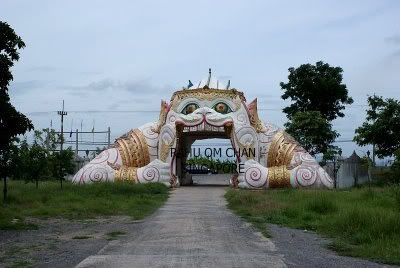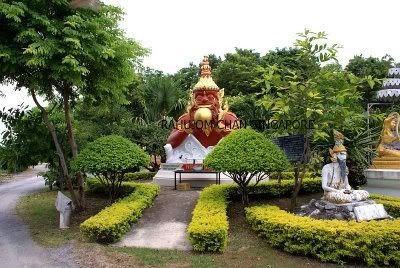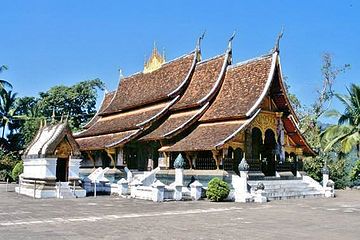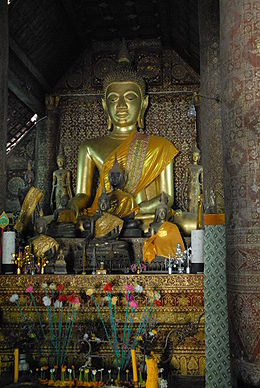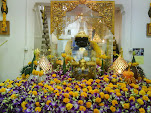Wednesday, 31 December 2008
Saturday, 27 December 2008
Wat Bang Nom Kho

Wat Bang Nom Kho (วัดบางนมโค) is a Buddhist temple in Sena district, Ayutthaya Province, Thailand.
Thursday, 25 December 2008
December
Chinese believed that as an elders, we are not allow to pray, to cry and to do anything for the dead. It's sad~~ really heart breaking and it's like a mission impossible because we are only human and we really missed them .
I wonder some times if he is able to receive the merit we have done for him and I wonder what can I do for him? The only thing i guess i can do for him is to write those mantras for him and pray that all will be well for him in the other world. Dilemma we can be, believing that if we keep on clinging on them ( thinking of them), calling out their names and cried for them, it will slow down their " reincarnation", we know we have to let go, but we just couldn't help it and loses control of ourselves.
We're told that time heals all wounds. That's not entirely true, of course. Time does have the ability to make that acute, searing pain of loss less intense, to make our red-hot emotions less painful. But our feelings of loss and emptiness may never completely go away....
人们常说,人生最痛苦的三件事莫过去少年丧父,中年丧偶,老年丧子。 再辛苦难熬的人生没有比失去自己的至爱更痛苦的事情了。珍惜眼前人!
Tuesday, 23 December 2008
Jataka - Buddha's Former Birth - Pt 2
 The Sama Jataka -Sama is shot by an arrow in his side by King Piliyakka.
The Sama Jataka -Sama is shot by an arrow in his side by King Piliyakka. The Grateful Parrot
The future Buddha was born as Mahasuka, a parrot who lived in a fig tree whose fruit fed him all year long. The God Saka decided to test him., and caused the tree to wither away. The parrot perched on the stump, unperturbed. Saka asked the parrot why he did not fly away. The parrot replied that he could not desert an old friend who had given him so much. On hearing these words, Saka offered him a boon. The parrot asked for his tree to live again, and it sprang back to life.
The Mahasuka Jataka
The Four Friends Jataka
 A story in a Buddhist sutra tells of four animal friends. One day they decided to work out who was the eldest and thus the wisest. To determine their ages, they recalled their first memories of a nearby tree. The elephant remembered it as tall as himself, the monkey as a small tree, and the hare as a sapling. However, the bird remembered it as a seed, which he planted himself. In accordance with this, the animals set themselves in order, with the wisest highest, to show respect and harmony. The future Buddha was the bird and the other animals were attendants and disciples.
A story in a Buddhist sutra tells of four animal friends. One day they decided to work out who was the eldest and thus the wisest. To determine their ages, they recalled their first memories of a nearby tree. The elephant remembered it as tall as himself, the monkey as a small tree, and the hare as a sapling. However, the bird remembered it as a seed, which he planted himself. In accordance with this, the animals set themselves in order, with the wisest highest, to show respect and harmony. The future Buddha was the bird and the other animals were attendants and disciples.
Monday, 22 December 2008
Jataka - Buddha's Former Birth - Pt 1
The future Buddha was born as Bhuridatta, a serpent divinity. He was captured and forced to perform for public entertainment. Despite these and other ignominies and torments of captivity, Bhuridatta remained free of anger, and ultimately regained his freedom.
The Bhuridatta Jataka
The Patient Prince
The Buddha-to-be was born as Prince Candakumara, whose nobility and patience were so great that an official at his father's court grew to hate him. Finally, the official convinced the king to offer his son as sacrifice. The prince faced his death calmly, but at the last moment he was saved by his mother, the queen. her prayers were answered by the god Indra, who interrupted the ceremony.
The Candakumara Jataka
Lifting the Chariot
When he was just a month old, the future Buddha, Prince Temiya, realized that as a ruler he would have to punish his subjects, and so he decided to remain silent and unmoving to avoid hurting other living beings. For 16 years he was tormented by trials to break his resolve. Finally, he was condemned to death. In the chariot that was taking him to his execution, Temiya finally moved: he got out of the chariot and raised it above his head with one hand, in a single action demonstrating his power and merit.
The Temiya Jataka
 Temiya confirms his strenght by lifting a chariot.
Temiya confirms his strenght by lifting a chariot.
Sunday, 21 December 2008
The Parable of Pilgrims
Without further ado, one of the monks took her on his back, carried her across and put her down on dry ground. Then the monks continued on their way. After a while the other monk suddenly burst out :" Surely it is not right to touch a woman. It is against the commandments to have close contact with woman. How can you go against the rules for monk?"... and so on in a steady stream.
The monk who had carried the girl walked along silently, but finally he remarked:" I set her down the river, But you are still carrying her."
Saturday, 20 December 2008
The Paramitas ~ The Perfections
In the Theravada Tradition -
The First Paramita ~Dana in Pali, the paramita of giving, applies to both material and non-material things: service of all kinds, helping others, teaching the Dharma and most importantly, always giving ourselves wholeheartedly to what we are doing right now.
The Second Paramita~Sila (morality) means behaving well at all times, living according to ethical rules or precepts, restraint of the senses and passions, good manners, self discipline, courtesy, consideration and politeness. Sila is also used as a general term for the daily practice of sustained awareness and mindful actions.
The Third Paramita~The Buddha himself admitted that before he was enlightened his heart did not delight in the thought of giving up worldly pleasures. Eventually he realized it was because he had not yet experienced life without them. The practice of renunciation (nekkhama) reduces the pull that sensual experience has on us, leading to relief, freedom and genuine joy.
The Fourth Paramita~The paramita of wisdom ( panna in Pali) means seeing the true nature of things, no longer contaminated by personal bias. With wisdom we can then live in accordance with things as they are, and realize inner peace and the truth.
The Fifth Paramita~Energy (Viriya) encourages us to abandon laziness and procrastination. Fear of not getting what we want can make us unwilling to wholeheartedly give ourselves to life's challenges. Viriya counterects this fearful " I won't" and transforms the heart.
The Sixth Paramita~Patience (Khanti) is considered the means for overcoming anger, ill-will and hatred, maintaining inner peace and tranquillity, and tolerating the intolerable. Patience is one of the most written-about practices in all Buddhism: it calms the passions and, in doing so, diminishes our illusory sense of "I", "me" and "mine" and makes us flexible, tolerant and warm.
The Seventh Paramita~Truthfulness (Sacca) means both honesty with other people and truthfulness with oneself - being honest about what our hearts really long for and courageously pursuing this with the whole of ourselves. if we practise inconsistently, or simply because we desire praise, it will never produce real result.
The Eighth Paramita~To attain any goal we need determination. Resolution (adhitthana) is sometimes called the four determinations: for discernment, for truth, for relinquishment and for calm. This paramita is also concerned with perseverance, the commitment to keep going forward in order to reach freedom and happiness.
The Ninth Paramita~Loving kindness (metta) means "good will" in all our action. If in all circumstances we behave with our hearts uncomplicated by our own desires, sedning out good wishes and love to all being, our actions will be kind and helpful in the deepest sense.
The Tenth Paramita~Equanimity (upekkha) is not at all the same as indifference. it refers to imperturbability, ans is one of the divine states, or brahma viharas. It is also considered to be one of the step toward enlightenment. It is only when the "I" is truly vanquished that there is no fear, and all action then arises from that state of equanimity, fully aware and fully present and thus completely in keeping with the situation.
Meditation~Translated as dhyana in Sanskrit or jhaha in Pali, meditation is a paramita of the Mahayana (Northern) tradition. Meditation simply means to cultivate and develop calm and peaceful awareness, concentration and insight. Eventually, sincere and dedicated practice can lead to the ultimate goal of enlightenment.
Friday, 19 December 2008
Wat Xieng Thong, Laos
Thursday, 18 December 2008
Xieng Kuan (Buddha Park), Vientiane, Laos
Buddha Park, also known as Xieng Khuan (as well as other variations of the spelling) is a sculpture park located 25 km southeast from Vientiane, Laos in a meadow by the Mekong River. It may be referred to as Wat Xieng Khuan (วัดเซียงควน) although the park is not a temple (Wat). The name Xieng Khuan means Spirit City. The park contains over 200 Hindu and Buddhist statues.
The park was built in 1958 by Luang Pu (Venerable Grandfather) Bunleua Sulilat. Luang Pu Bunleua Sulilat was a priest-shaman who integrated Hinduism and Buddhism and later fled from Laos to Thailand after the revolution in 1975. There, he built another sculpture park, Sala Keoku in Nong Khai.
The statues are made of cement and are ornate, and sometimes bizarre, in design. The statues appear to be centuries old, though they are not. There are numerous sculptures of Buddha and characters of Hindu lore. There are also sculptures of humans, gods, animals, and demons. One notable sculpture resembles a giant pumpkin. It has three stories representing three levels - Hell, Earth and Heaven. Visitors can enter through an opening which is a mouth of a 10 ft tall demon head and climb staircases from hell to heaven. Each story contains sculptures depicting the level. At the top, there is a vantage point where the entire park is visible. Another sculpture, an enormous 40 m high reclining Buddha, is also a park attraction.
Admission to the Buddha Park is 5,000 Kip. There's another 2,000 Kip fee for a camera.
You can get to the Buddha Park by tuk-tuk. Most of the drivers around town soliciting tourists can take you there. Expect to pay around 700 Baht.
春府寺庙大佛遭泼强酸
寺庙内正在建缮的1尊大佛,被泼洒强酸,导致佛像受损,预估经济损失约10万铢。
这尊佛像座落在瓦挽拉蒙佛寺正在建设的佛堂之内,投资建造费达到130万铢。可是该佛像却在日前被不法分子泼洒强酸,导致佛像的肩部、左臂等部位大面积被腐蚀,粗略统计经济损失约为10万铢。
瓦挽拉蒙寺庙的方丈表示,该尊大佛受到附近的居民敬仰,寺庙方还在本月5日举行大型诵经法会恭祝皇上圣体安康。
据悉,春武里瓦挽拉蒙寺庙曾在不久前,因在佛塔上塑造前总理塔信等政治人物的头像,招致民主联盟的不满,民盟不仅派人在寺外示威,而且还通过多个渠道给寺庙方面施加压力,最后寺庙方已将塔信等人的头像拆除,才平息了民盟的怒气。
宗教信仰为什么要和政治挂钩呢?如果要发泄心中的不满,也不应该把气出在佛像身上.
本文引用地址:http://www.udnbkk.com/article/2008/1209/article_46147.html
Wednesday, 17 December 2008
Rahu in Pattaya
 There is an article on this temple, unfortunately it's in thai.
There is an article on this temple, unfortunately it's in thai. Source - http://www.pattayadailynews.com/thai/shownews.php?IDNEWS=0000006790
Source - http://www.pattayadailynews.com/thai/shownews.php?IDNEWS=0000006790Tuesday, 16 December 2008
Monks use snake’s blood to exorcise ‘possessed’ playground
The prestigious H.M. the Kings Rachaprachanakroh Foundation school, which caters mainly for Muslim children, was closed for a week while nine Bhuddist and one Chinese monk exorcised the school grounds, spreading snakes’ blood and pigs’ blood around the playing area to drive off the ‘spirits’.
A Muslim ceremony was also performed to persuade the spirits to leave the school. The school’s assistant headmaster, Suda Wonnuha, said the younger children were terrified by the older students irrational behaviour.“We had to cancel all classes for a week,” she said. Kongsak Khoburi, an educational assistant at the school said the ‘crazy behaviour’ started on November 19 when a Year 4 boy ‘displayed worrying behaviour in class’.“He was sitting frozen to his seat, and then he suddenly started screaming,” he said. The boy was taken to the school’s infirmary, but teachers were at first skeptical and thought the students were ‘playing games’. But when disciplinary action didn’t shake the usually boisterous 16-year-old, they realised it was something more sinister.
As the day wore on, the strange behaviour spread to other parts of the school. Groups of primary school girls began dancing ritualistically and chanting in class. Their teachers were unable to control them. By the next morning, students of all ages were doing weird things, and by the Friday, they were uncontrollable. Mr Konsak said there was pandemonium and wild outbursts by children in the playground.The following Monday, the headmaster closed the school for a week.Mr Konsak played down claims that the ‘demons’ were unhappy when a sacred tree near the school was cut down. A spirit house under the tree was destroyed when the tree was cut down to make way for a building development. Mr Konsak said, in Buddist-Thai culture, it is believed that during sampawesi, or when the soul changes condition, it can become open and allow spirits to enter.“Some people believe the spirits have no home and nowhere to go, so they enter the bodies of humans and communicate through them,” he said.
A handful of children playing in the deserted school grounds seemed blissfully unaware of anything untoward occurring. Two girls happily pushed each other around in a make-shift sled, while ten-year-old Panya sat next to Mr Konsak reading his English books. Mr Konsak doesn’t believe his students were possessed by spirits.“I think the children were bored, and were acting this way as some sort of practical joke,” he said.“They have convinced some of their classmates to act this way, and it has escalated from there,” he said.“It has turned into a large scale problem for staff. “But we should understand that a lot of these children come from extremely traumatized backgrounds and many lost family in the tsunami. “Some of them have very different emotional needs to normal children, and many of them come from very poor backgrounds."“They depend on the school for food and housing, and more than 60 students live on campus.”“Most of them returned home when the school was closed, but some stayed, either because they have no family or they have problems at home.”
Source- Phuket Post (2008-12-15 11:22:49)
by Fraser Morton
Monday, 15 December 2008
solar eclipses in 2009
On Wednesday, 2009 July 22, a total eclipse of the Sun is visible from within a narrow corridor that traverses half of Earth. The path of the Moon's umbral shadow begins in India and crosses through Nepal, Bangladesh, Bhutan, Myanmar and China. After leaving mainland Asia, the path crosses Japan's Ryukyu Islands and curves southeast through the Pacific Ocean where the maximum duration of totality reaches 6 min 39 s. A partial eclipse is seen within the much broader path of the Moon's penumbral shadow, which includes most of eastern Asia, Indonesia, and the Pacific Ocean.
So Rahu's in Action again! I guess there will be a big event in Wat Srisathong on that day!
胡
Sunday, 14 December 2008
Saturday, 13 December 2008
Friday, 12 December 2008
walking out of Rahu’s mouth
Thursday, 11 December 2008
Wednesday, 10 December 2008
Tuesday, 9 December 2008
Rahu Cave
Name of Temple - วัดป่ายุบ - Wat Bayup
Location - Mooban 5, Tambon Sattahip, Ampur Saatahip, Chonburi Province
Credits - Richard Barrow & Yeows, Paknam Web
Monday, 8 December 2008
Happy Birthday!
- Longevity Noodle ( Dye with edible black colouring)
- Black Coffee
- Chicken Essence
- Century egg
- Black Biscuit
- Muffin
- Chin Chao
- Black Glutinous Rice with Glutinous Ball
And also a jasmine/Orchid Garland for HIM
Another Legend of Phra Rahu
 It's THE month for Rahu, so why not share some interesting legend of HIM!
It's THE month for Rahu, so why not share some interesting legend of HIM! Sunday, 7 December 2008
Legend of Phra Rahu
It appeared in Attha Katha both in Tim Nidai and Sungyatta Nikai which described the size of Phra Rahu as follow:
"He is 4,800 yoch tall. His chest is 1,200 yoch wide.His forehead is 50 yoch wide and his nose is 30 yoch long," [ yoch is thai linear measure.,1 yoch is 16 kilometers]
In Triphum Katha described the size of Phra Rahu that,
"He is 98,000 yoch tall, measured around his head is 26,000 yoch,his forehead is 300 yoch wide, around his nose is 300 yoch, the space between his eyes and eyebrows is 90 yoch , each of his eyebrow is 200 yoch long, his mouth is 200 yoch wide and 300 yoch deep. Each of his palm is 200 yoch wide and his hand and foot's hair is 30 yoch long"
In thai astrology mentions that Phra Rahu was made up of 12 heads of jack-o-lantern with 12 wind power or the god of storms. He lives in black mansion. He has got bronze body and wears blonde costumes.
He usually lives in clouds and fog, occupies the west and Thai alphabets ย ร ล ว
Another legend in Thai astrology goes that Phra Rahu is the star of wind lives in the northeast with and make friend with Saturn. He is also a couple of balanced-power with the moon. He likes the fire zodiacal signs: Aries, Leo and Sagittarius.
People represent Phra Rahu to number 8 with 12 power which is the part of the power of all the planets power equals 108. When number 8 is lain down in linear it becomes the symbol of infinity .
Source - Mr.Jiaranai Chockmongcholchaichana
Saturday, 6 December 2008
Thai website for Rahu Temple
http://watphrarahoo.com
A set of Rahu Picture


 Since day one when we started to know about Rahu, we were told that 8th December is the day for HIM. But frankly speaking, till date, I have yet to be able to verify what was told to me. I've went thru Thai website on Rahu, went to a few Forum to seek advice from devotees all over the world, in vain.
Since day one when we started to know about Rahu, we were told that 8th December is the day for HIM. But frankly speaking, till date, I have yet to be able to verify what was told to me. I've went thru Thai website on Rahu, went to a few Forum to seek advice from devotees all over the world, in vain. Friday, 5 December 2008
Rahu Cave
Thursday, 4 December 2008
Right Behavior
- The Eight-Fold Noble Path consists of:
|
- Right view means to thoroughly understand the Fourfold truth, to believe in the law of cause and effect, and not to be deceived by appearances and desires. (The law of cause and effect states that: The world is a vast concurrence of causes and effects. Everything happening now is the result of what happened before, and everything which shall happen later is the result of what is happening now. Nothing remains unchanged forever. Therefore, it is an error to become attached to any object, since no object has an enduring reality to it).
- Right thought means the resolution not to cherish desires, not to be greedy, not to be angry, and not to do any harmful deed.
- Right speech means the avoidance of lying words, idle words, abusive words, and double-tongues.
- Right behavior means not to destroy any life, not to steal, and not to commit adultery.
- Right livelihood means to avoid any life that would bring shame.
- Right mindfulness means to maintain a pure and thoughtful mind.
- Right concentration means to hold the mind right and tranquil for its concentration, seeking to realize the mind's pure essence.
- a place of worship
- an edifice devoted to special or exalted purposes
- A holy place not to be tainted by illegal activities and unacceptable behaviors.
Many people tends to forget about the teaching of 8 fold noble path . They tends to do the wrong thing at the wrong time, at the wrong place.
As an Adult, You don't need a God, a Bible, Ten Commandments - or even Five Precepts - to tell you right from wrong. You know when you're doing something you shouldn't be doing and therefore stop it before it gets out of hand and before it's too late. Always bear in mind~~Don't trouble trouble until trouble troubles you!

